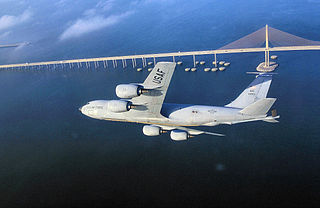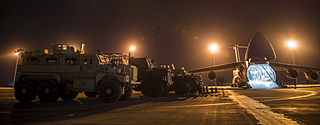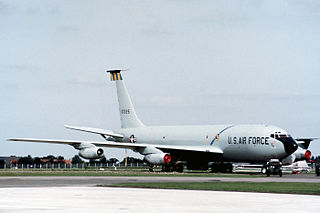
The 100th Air Refueling Wing, nicknamed the Bloody Hundredth, is a United States Air Force unit assigned to the Third Air Force, United States Air Forces in Europe – Air Forces Africa. It is stationed at RAF Mildenhall, Suffolk, United Kingdom. It is also the host wing at RAF Mildenhall.

The 379th Air Expeditionary Wing is a provisional United States Air Force unit assigned to Air Combat Command. As a provisional unit, it may be activated or inactivated at any time.

The 499th Air Refueling Wing is an inactive United States Air Force (USAF) unit that was last active at Westover AFB, Massachusetts in June 1966.

The 497th Air Expeditionary Group is a provisional United States Air Force unit. It is assigned to Pacific Air Forces to activate or inactivate as needed.

The 70th Air Refueling Squadron is an Air Force Reserve Command unit, assigned to the 349th Operations Group at Travis Air Force Base, California. It is an associate of the active duty 9th Air Refueling Squadron, United States Air Force, and operates the McDonnell Douglas KC-10 Extender aircraft conducting mobility, and air refueling missions. The squadron has served in this role since 1994.

The 91st Air Refueling Squadron is part of the 6th Air Mobility Wing at MacDill Air Force Base, Florida. It operates the Boeing KC-135R Stratotanker aircraft conducting air refueling missions.

The 99th Air Refueling Squadron is part of the 6th Air Mobility Wing at MacDill Air Force Base, Florida, but is stationed at Birmingham Air National Guard Base, Alabama. It is an Active Associate Unit, an active duty component attached to the Alabama Air National Guard's 117th Air Refueling Wing. The 99th Air Refueling Squadron works with, supports and flies the 117th Air Refueling Wing's Boeing KC-135R Stratotanker aircraft.

The 344th Air Refueling Squadron is a unit of the US Air Force, part of the 22d Air Refueling Wing of Air Mobility Command at McConnell Air Force Base, Kansas. It operates the Boeing KC-46 Pegasus aircraft conducting aerial refueling missions.

The 385th Air Expeditionary Group is a provisional United States Air Force unit assigned to Air Mobility Command to activate or inactivate as needed. It was last known to be stationed at Incirlik AB, Turkey. It is currently a tenant unit of the 379th Air Expeditionary Wing at Al Udeid Air Base, Qatar.

The 905th Air Refueling Squadron is a United States Air Force Reserve unit. It is presently active as an element of the 931st Air Refueling Wing at McConnell Air Force Base, Kansas. The squadron was previously inactivated at the end of 2010 when the 319th Air Refueling Wing at Grand Forks Air Force Base lost its operational mission and became the 319th Air Base Wing.

The 906th Air Refueling Squadron is an active United States Air Force unit. It is an active associate squadron and part of the 375th Air Mobility Wing at Scott Air Force Base, Illinois.

The 22d Expeditionary Air Refueling Squadron is a provisional United States Air Force unit, assigned to Air Mobility Command. It is engaged in combat operations as part of the Global War on Terrorism in Afghanistan. Its current status and location are undetermined. The squadron's permanent designation is the 22d Air Refueling Squadron.

The 379th Expeditionary Operations Group is a provisional United States Air Force unit assigned to the United States Air Forces Central. It is the flying component of the 379th Air Expeditionary Wing, stationed at Al Udeid AB, Qatar. The Group is the flying component of the 379th Air Expeditionary Wing, with more than 90 combat and support attached aircraft, including eight coalition airframes. Aircraft come from every US service, the United Kingdom, and Australia.

The 527th Bombardment Squadron is an inactive United States Air Force unit. It was last assigned to the 379th Bombardment Wing at Homestead Air Force Base, Florida, where it was inactivated on 9 January 1961, when its parent wing converted to the Boeing B-52H Stratofortress..

The 524th Bomb Squadron is an inactive United States Air Force unit. It was last assigned to the 379th Bombardment Wing at Wurtsmith Air Force Base, Michigan, and was inactivated on 15 December 1992 as the base was drawing down prior to closure.

The 407th Air Refueling Squadron is an inactive United States Air Force unit. It was last assigned to the 42nd Bombardment Wing at Loring Air Force Base, Maine, where it was inactivated on 1 October 1990.

The 90th Expeditionary Air Refueling Squadron is a provisional United States Air Force unit. Until March 2013, it was assigned to the 385th Air Expeditionary Group at Incirlik Air Base, Turkey. It then departed for an undisclosed location in Southwest Asia.

The 904th Expeditionary Air Refueling Squadron is an inactive United States Air Force unit. It was last assigned to the 320th Bombardment Wing at Mather Air Force Base, California, where it was inactivated on 30 September 1986.

The 379th Space Range Squadron is an Air Force Reserve unit. It is assigned to the 926th Wing, and is located at Schriever Air Force Base, Colorado.

The 365th Bombardment Squadron is an inactive United States Air Force unit. It was first activated in March 1942. After training with Boeing B-17 Flying Fortress bombers in the United States, the squadron deployed to the European Theater of Operations, where it participated in the strategic bombing campaign against Germany. The squadron was twice awarded the Distinguished Unit Citation for its combat actions. Following V-E Day, it moved to the continent of Europe and engaged in photographic mapping until inactivating in December 1946.






























